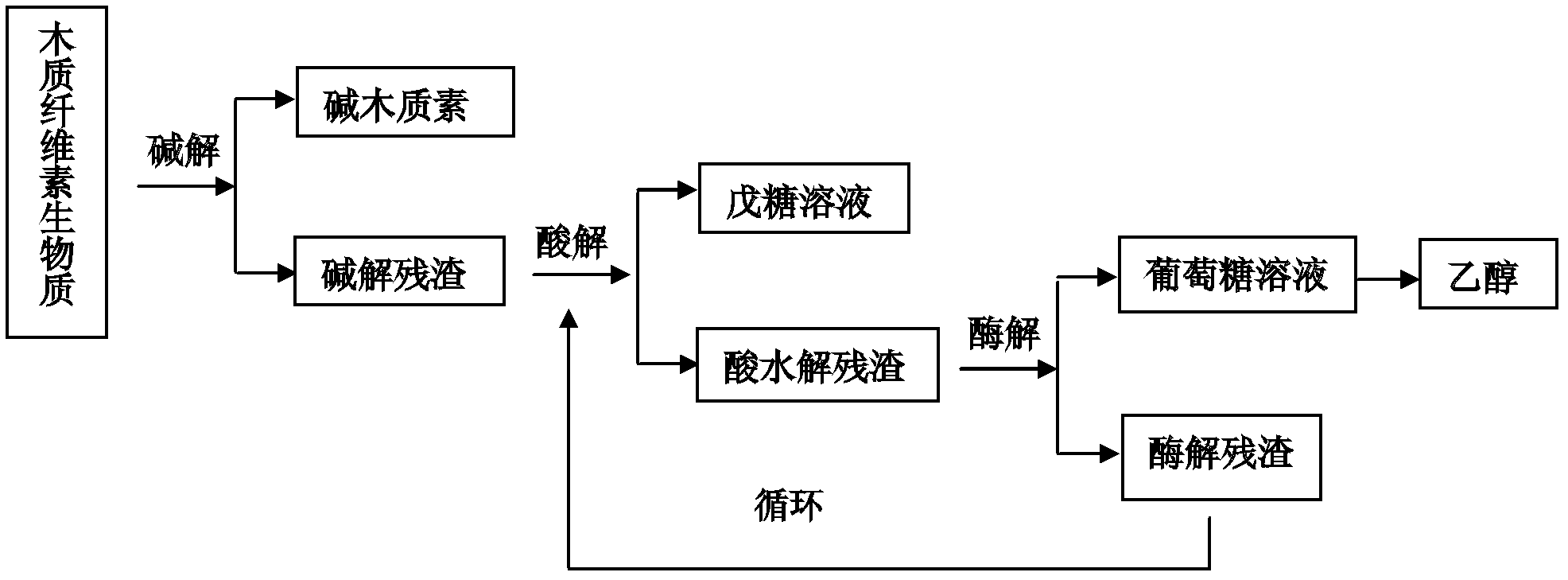Comprehensive utilization method of lignocellulose biomass
A technology of lignocellulose and biomass, which is applied in the field of comprehensive utilization of cellulose, hemicellulose and lignin in lignocellulosic biomass, can solve the problems of high hemicellulose and cellulose extraction rate, and cannot be obtained at the same time. To achieve the effect of improving the extraction rate
- Summary
- Abstract
- Description
- Claims
- Application Information
AI Technical Summary
Problems solved by technology
Method used
Image
Examples
Embodiment 1
[0056] (1) Alkali solution to extract alkali lignin
[0057] 10.6kg of crushed corn cobs (mass composition: moisture 6.12%, cellulose 35.19%, hemicellulose 32.1%, lignin 23.7%, other 2.95%, the same below) were broken, washed with water to remove dust, and then hydrogenated Alkaline hydrolysis with sodium oxide solution, wherein the liquid-solid volume ratio is 5:1, the concentration of sodium hydroxide solution is 3%, the temperature is raised to 70°C, and after 1 hour of cooking alkaline hydrolysis, the alkali hydrolysis residue and alkali lignin solution are separated , clean the alkali lignin residue with 10kg of water, and the cleaning liquid is combined with the alkali lignin solution; finally obtain 23.77kg alkali lignin residue (about 65% moisture content) and 46.22kg alkali lignin solution; in the alkali lignin solution The content of alkali lignin is 2.46%, and the extraction rate of alkali lignin is 45%.
[0058] The extraction rate formula of alkali lignin is as f...
Embodiment 2
[0074] (1) Alkali solution to extract alkali lignin
[0075] 10.6 kg of pulverized corn cobs were broken, washed with water to remove dust, and then carried out alkaline hydrolysis with sodium hydroxide solution, wherein the liquid-solid volume ratio was 20:1, the concentration of sodium hydroxide solution was 0.8%, and the temperature was raised to 100 ° C. After 2 hours of cooking alkaline hydrolysis, the alkali hydrolysis residue and alkali lignin solution are separated, and the alkali hydrolysis residue is cleaned with 10 kg of water, and the cleaning solution is merged with the alkali lignin solution; finally, 23.61 kg alkali hydrolysis residue (moisture content) is obtained About 65%) and 19.63kg of alkali lignin solution; the content of alkali lignin in the alkali lignin solution is 0.55%, and the extraction rate of alkali lignin is 43%.
[0076] (2) acid hydrolysis
[0077] Get all the alkali hydrolysis residues obtained by the alkali solution treatment in the present...
Embodiment 3
[0085] (1) Alkali solution to extract alkali lignin
[0086] 10.6 kg of pulverized corn cobs were broken, washed with water to remove dust, and then carried out alkaline hydrolysis with sodium hydroxide solution, wherein the liquid-solid volume ratio was 10:1, the concentration of sodium hydroxide solution was 5%, and the temperature was raised to 40 ° C. After 6 hours of cooking alkaline hydrolysis, the alkali hydrolysis residue and alkali lignin solution are separated, and the alkali hydrolysis residue is cleaned with 10 kg of water, and the cleaning solution is merged with the alkali lignin solution; the final 24.44 kg alkali hydrolysis residue (moisture content 65 %) and 90.88kg of alkali lignin solution; the content of alkali lignin in the alkali lignin solution is 1.11%, and the extraction rate of alkali lignin is 40%.
[0087] (2) acid hydrolysis
[0088] Get all the alkali hydrolysis residues obtained by the alkali solution treatment in the present embodiment (1), the...
PUM
 Login to View More
Login to View More Abstract
Description
Claims
Application Information
 Login to View More
Login to View More - R&D
- Intellectual Property
- Life Sciences
- Materials
- Tech Scout
- Unparalleled Data Quality
- Higher Quality Content
- 60% Fewer Hallucinations
Browse by: Latest US Patents, China's latest patents, Technical Efficacy Thesaurus, Application Domain, Technology Topic, Popular Technical Reports.
© 2025 PatSnap. All rights reserved.Legal|Privacy policy|Modern Slavery Act Transparency Statement|Sitemap|About US| Contact US: help@patsnap.com

